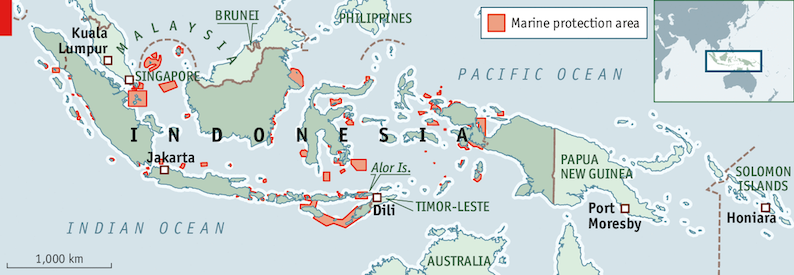Saving Indonesia’s fisheries - Plenty more fish in the sea?
visit: from The Economist<
The government tries to preserve a fecund part of the coral triangle
Dec 21st 2013 | ALILA TIMUR, ALOR ISLANDS | From the print edition

HE LEARNED to fish the turquoise-coloured seas of the Alor archipelago in eastern Indonesia from his father. But it is not a vocation Samsul Osman wants for his own four children. He says that these days traditional fishermen like himself must paddle their outrigger canoes far out to sea for a catch of skipjack tuna that sells for about 60,000 rupiah (about $5). Sometimes his family goes hungry. The other fishermen sitting cross-legged on the white sand at Alila Timur, where traders come to buy tuna to sell at the markets of Kalabahi, the islands’ sleepy capital, nod their heads. Fish stocks are dwindling.
Alor is at the centre of the “coral triangle”, 6m square kilometres of the most biodiverse oceans on earth. These waters contain two-thirds of the world’s coral species, and twice the number of species of reef fish found anywhere else (more than 3,000). New species are still being discovered by scientists in Indonesia, such as, recently, H emiscyllium Halmahera, a “walking” shark. But climate change and warming oceans, overfishing and destructive fishing practices, along with pollution from coastal communities and industries, threaten the fragile ecosystems that support underwater life, as well as millions of traditional fishermen like Mr Osman.
Yet, besides the huge intrinsic value of the oceans to the planet, there is a compelling economic case for conserving them. Indonesia’s seas are vitally important for its own food security, and for the livelihoods of the 60m people that live close to its 95,000km (59,000-mile) coastline. Indonesia’s fisheries ministry wants to boost fish production to 20m tonnes in 2014, an increase of 14% over 2013. Fisheries exports, mostly to America, Asia and Europe, are a growing source of foreign exchange, worth $3.9 billion in 2012.
Such commercial pressures mean that simply telling governments to restrict fishing does not work. According to Lida Pet-Soede of the WWF, a conservation NGO, governments are more susceptible to the economic case for conservation: that fisheries will be sustainable only if big parts of the ocean are protected. And some do seem to be listening. In 2007 Indonesia’s president, Susilo Bambang Yudhoyono, asked the leaders of the five other coral-triangle countries (Malaysia, Papua New Guinea, the Philippines, the Solomon Islands and Timor-Leste) to join a regional conservation initiative. Two years later they agreed on an “action plan” to manage their resources by, among other things, establishing marine protected areas (MPAs). The initiative has financial support from the American and Australian governments and from multilateral donors, such as the Asian Development Bank.
So far Indonesia itself has established MPAs covering some 16m hectares (see map). By 2020 it plans to increase protected areas to 20m hectares, or about 10% of its total waters, covering a range of coastal and marine ecosystems, from deep waters and coral reefs to the mangroves and seagrasses where fish spawn. This is only a small step towards the 30% of the world’s oceans that scientists say must be protected to forestall a collapse in fisheries. But the protection of even 10% of Indonesia’s waters would be a big achievement.
The trouble is that Indonesia’s MPAs often seem to exist only on paper. A recent study by the World Resources Institute, a think-tank in Washington, rated only three of Indonesia’s 170-odd MPAs as “effective”. Sometimes the designs are flawed, with too few restrictions on fisheries. But more often the rules are flouted.
Moreover, the problems with Indonesia’s MPAs frequently originate far inland. Widespread deforestation of watersheds, for example, has increased the run-off of sediments and nutrients that impede coral growth by suffocating reefs or making them overgrown with algae. Sickly, stunted reefs are more vulnerable to ocean acidification and coral “bleaching” linked to carbon emissions and global warming.
Alor unto itself
Simeon Thobias Pally, Alor’s elected leader, approved a 400,083-hectare MPA in 2009. Sites are set aside as “no-take” zones so that fish can reproduce and their numbers recover. But frequent changes in personnel and turf wars between the national and local governments, as well as between the fisheries and forestry ministries, have all hampered implementation. Rahmin Amahala, the head of fisheries in Alor, hopes that the formal launch of the MPA, which has long been stalled, will mean more resources, which are sorely needed. At present the coastal police force has only two speedboats—and one of them is broken. Without patrols, it is impossible to catch the fishermen who are responsible for the illegal blast-fishing that has razed many of the islands’ coral reefs, let alone to enforce rules on sea zoning and fishing gear.
As the traders at Alila Timur cart off buckets brimming with freshly caught tuna, Mr Osman and his fellow fishermen are venting their frustration. They say they are grateful for the fish here, and understand that fish must reproduce so that stocks are replenished. But it is becoming harder to make a living as more boats arrive from already denuded waters to the west. “We cannot hide our anger any longer,” says one.
| Attachment | Size |
|---|---|
| F-New.png | 237.18 KB |
- Editor1's blog
- Login to post comments